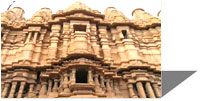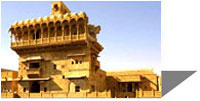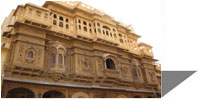Jaisalmer is a great place to simply wander. The old city was once completely surrounded by an extensive wall, much of which has sadly been ripped away in recent times for building material. Some of it remains, however, including the city gates and, inside them, the massive fort which rises  above the city and is the essence of Jaisalmer. The main market area is directly below the hill, while the banks, the new palace and several other shops and offices are near the Amar Sagar Gate to the west. Jaisalmer's past glories can be seen in its impressive golden fort on Trikuta Hill that dominates the horizon. The fort houses a township with markets, palaces, temples and exquisite carved sandstone havelis. Today, these homes are national treasures and art museums that are still inhabited. This last outpost of the Indian Republic is valued for its heritage as much as for its brave citizens, its people and culture, colourful festivals and crafts have placed Jaisalmer on the world tourist map.
above the city and is the essence of Jaisalmer. The main market area is directly below the hill, while the banks, the new palace and several other shops and offices are near the Amar Sagar Gate to the west. Jaisalmer's past glories can be seen in its impressive golden fort on Trikuta Hill that dominates the horizon. The fort houses a township with markets, palaces, temples and exquisite carved sandstone havelis. Today, these homes are national treasures and art museums that are still inhabited. This last outpost of the Indian Republic is valued for its heritage as much as for its brave citizens, its people and culture, colourful festivals and crafts have placed Jaisalmer on the world tourist map.
Places of Interest
Jaisalmer Fort
Jaisalmer Fort is the most alive of any museum, fort or palace that you are likely to visit in India. It was built in 1156 by the Rajput ruler Jaisala. About a quarter of the old city's population resides within the fort walls. The fort is entered through a forbidding series of massive gates leading to a large courtyard.
Jain Temples 
Within the fort walls are a group of beautifully carved Jain temples built between the 12th and 15th centuries. They are dedicated to Rikhabdev and Sambhavanth. Gyan Bhandar or Library : Some of the oldest manuscripts of India are found in this library established as a part of Jain temples.
Desert Culture
Centre and Museum The Desert Culture Centre and Museum is a place which gives visitors an inside view of Jaisalmer, its people and the area around it. The museum has an extensive collection of old coins, textile, weaponry, traditional Rajasthani musical instruments and fossils found in the desert.
Havelis in Jaisalmer
Salim Singh-Ki-Haveli 
This haveli was built about 300 years ago and part of it is still occupied. Salim Singh was the prime minister when Jaisalmer was the capital of a princely state, and his mansion has a beautifully arched roof with superb carved brackets in the form of peacocks. The mansion is just below the hill and it is said, once had two additional wooden storeys in an attempt to make it as high as the Maharaja's palace, but the maharaja had the upper storeys torn down.
Patwon-Ki-Haveli 
It is one of the largest and most elaborate houses in Jaisalmer. It is five storeys high, extinsively carved. It is divided into six apartments, two owned by the Archaeological Survey of India, Two by families who operate craftshops here, and two private homes.
other on the left. Yellow sandstone elephants guard the building, and even the front door is a work of art.
Climate
Jaisalmer has the classic desert type climate – extremely hot summer days with cool nights and bitterly cold winter with freezing cold nights. On summer days, the average temperature is around 41°C but can go as high as 50°C while the minimum average is around 25° C. The summer season between the months of March/April and August/September is not just hot but also prone to frequent dust and sand storms accompanied by high velocity winds. Rainfall is minimal with the region barely receiving 15cm of rain annually. Winter days in the months between November and March are warmer than expected with average temperatures of around 23.6°C, partly because the desert sun still retains its intensity but night temperatures fall to below -1°C, though the average is approximately 5°/6°C. Frost is a common phenomenon in the winter nights.
How to Reach
- By Air
Indian Airlines operates flights to Jodhpur, Jaipur, Mumbai and Delhi from Jaisalmer.
- By Bus
There are many deluxe buses operating daily from Jaisalmer to Jodhpur, Jaipur, Bikaner.
- By Train
There are two trains IJPJ and Jodhpur express which operates daily from Jaisalmer to Jodhpur.